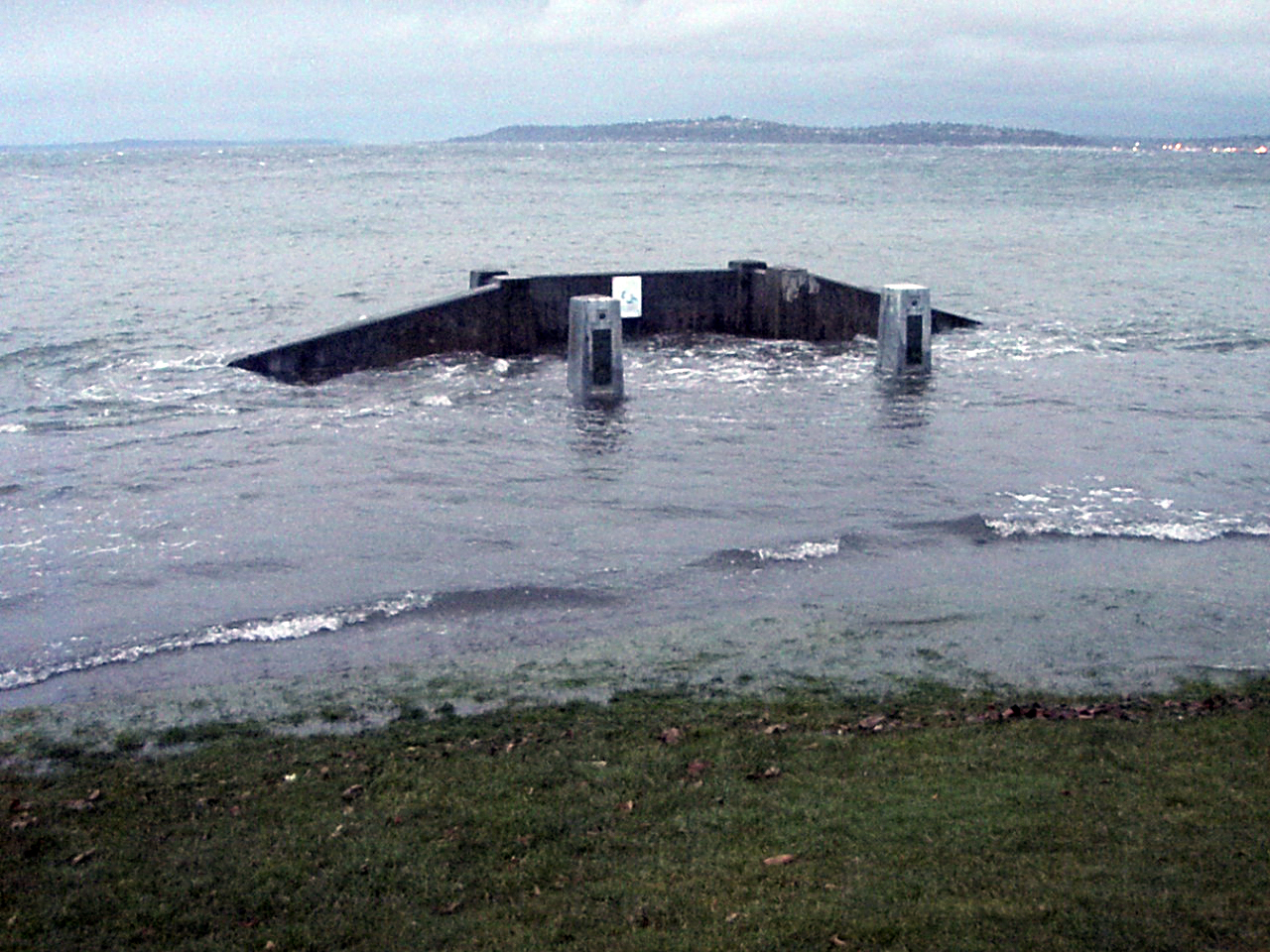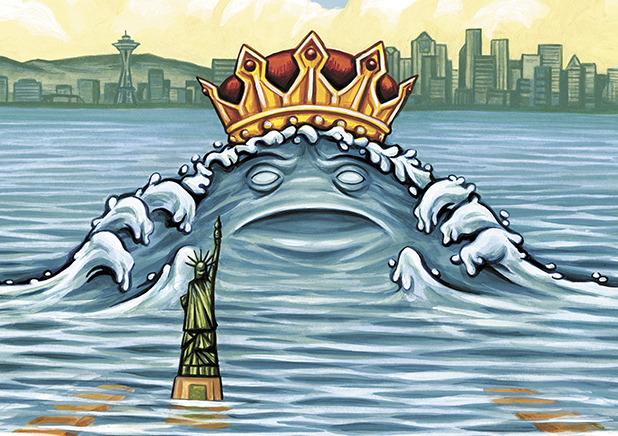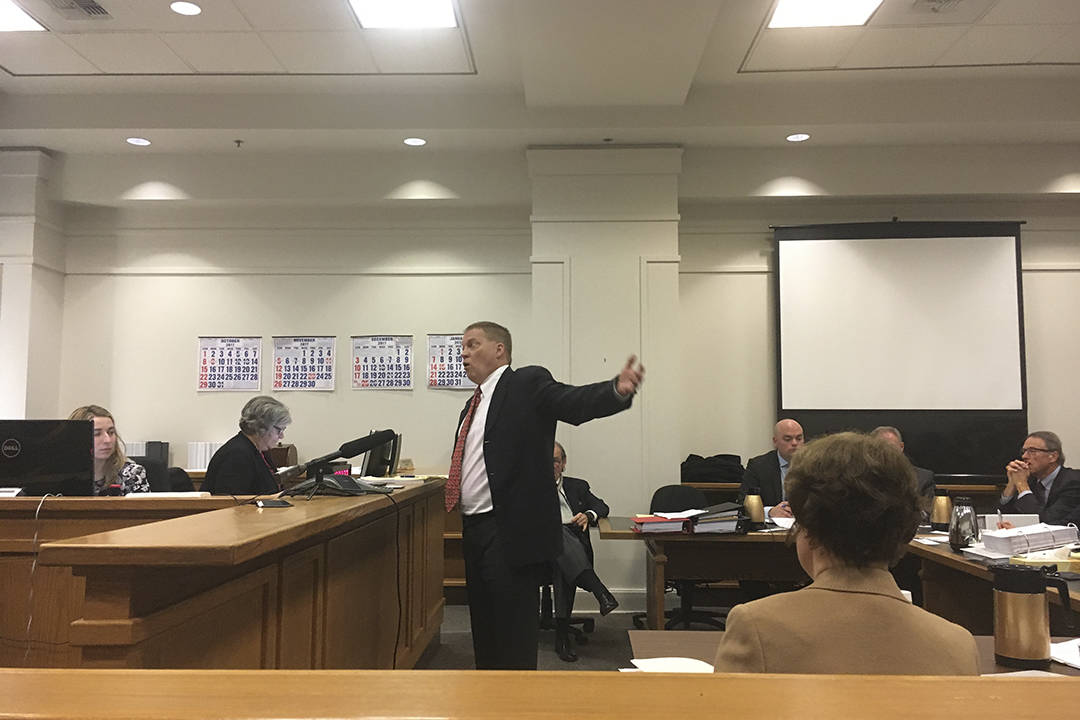The Tlingit people of southern Alaska have a story about when the tides began. There was an old woman in a cave at the end of the world who controlled the ocean with a line in her lap. She used to hold the line very tightly, never letting the seas rise or fall, which meant the people could not eat all the seafood that would otherwise be revealed by a low tide.
When the people started to go hungry, their helper, Raven, flew across the great water to the woman and kicked sand at her. The old woman dropped the line, causing the water to drop, and the Tlingit had a feast. But soon they saw that when the tide was always out, fish could not come back up the shore and were dying as a result. So Raven went back and helped the old woman get hold of the line again. In thanks, she agreed to let the water in and out, so the fish could live and the people could eat.
Another legend, this one from the Haida, indiginous to northern British Columbia, tells of a stranger who showed up on the shore of a village on the ocean. It was low tide and she sat down at the edge of the water. When the tide started to move in, she stood up, walked up shore a bit, and sat again. Each time she sat down, the water would follow her up. Soon she was at the village, and the water had followed her. Sensing their watery doom, people built rafts to survive the flood. Eventually she was high on a mountain, and all the land was under water.
For these tribes, and others along the Pacific, the ocean was both a provider and, potentially, a destroyer.
That still holds true for the Swinomish Tribe on Fidalgo Island in Skagit County. For thousands of years, the peoples of the tribe have lived off the bounty of the ocean, and to this day feast on shellfish harvested during low tides on their coastal reservation. Yet up to 15 percent of the reservation could be put under water by rising sea levels, according to a study the tribe completed in 2009. That includes 160 homes worth $83 million, as well as businesses and the roads that provide the tribe’s only link to the mainland.
In addition to an economic impact, rising sea levels could have a serious impact on the tribe’s culture—archeological sites could end up under water, and the salmon and clam harvests that have sustained its people could be seriously compromised.
“It’s safe to say, we’re facing devastation in the loss of resources,” says Debra Lekanoff, Swinomish intergovernmental affairs liaison. “As sea levels rise and our clam beds are destroyed and salmon are impacted, we’re asking, how can we address this?”
With climate change,
man has seized the tide line from the old woman in the cave. And we are slowly pulling it up over our own villages.
With each ton of coal burned and gallon of gas guzzled, humans are placing more and more heat-trapping gases into the atmosphere—hotboxing ourselves with carbon dioxide. As the temperature rises, so too will sea levels, for two reasons: First, warmer global temperatures—2014 is thought to have been the hottest year ever recorded globally, though the data is still to be finalized—cause the polar icecaps to melt, introducing more water into the ocean. Second, ocean temperatures are rising, which is causing water molecules to expand. Thermal expansion means that the water in the ocean takes up more room, causing it to move up shorelines across the globe—anywhere between 1 and 6 feet, depending on which study you read.
All of which is quite frightening, but still fairly abstract: An extra four feet of water in Puget Sound is hard to picture without any kind of visual demonstration.
Which is why climate activists hope you’ll take a look at the water this Friday and Saturday, when the year’s highest tides will give a little preview of what could be the new normal in a few decades.
Compared to other
environmental catastrophes, climate change has met with a notably listless response from humans. Part of the problem is that the solutions climate change demand are extreme, and become more extreme the longer it goes unaddressed. But another reason is that it’s very difficult to point at any specific natural occurrence and definitively blame it on a warming planet. Forests have always caught on fire, and geologists tell us that California was experiencing droughts long before the internal combustion engine was invented. Blaming these things on climate change opens the door to deniers’ counter-claims that subzero temperatures prove global warming is a hoax. In fact, Wheel of Fortune host and prominent climate skeptic Pat Sajak did just that last year on Twitter.
So it is important to be clear that nobody is suggesting that the high tides forecast for Friday and Saturday are caused by climate change. Rather, these so-called “king tides” are a phenomenon as old as the ocean itself.
Tides, of course, are caused by the gravitational pull of the moon and, to a lesser but significant extent, the sun. Tides are highest during full and new moons, since these are the times that the moon and sun are aligned in such a way that they work together. On top of this, in the winter the moon is closer to Earth than in the summer, so it has a more pronounced effect on the tides this time of year. Taken all together, these factors cause the highest tides of the year to come in the winter. Other things like low pressure systems and high winds can push tides even higher; in 2012 the king tide reached 14.5 feet in Seattle, setting a new local record.
High tides on Friday and Saturday aren’t forecast to reach anything close to 2012 levels. Still, at 13 feet, they should be 3 feet higher than average.
What does any of this
have to do with climate change? Experts say that by the end of the 21st century, the tides we’ll see later this week could be decidedly commonplace everyday occurrences.
Predicting exactly how sea levels will change in any given spot is tricky because of other factors such as tectonic shifting. In parts of Washington, namely the northwestern portion of the Olympic Peninsula, sea levels could actually drop 9 inches by 2100, since the ocean floor is dropping. However, nowhere in Puget Sound is that expected to happen, meaning the sea-level rise won’t be a matter of if, but of how much. Projections range between 6 inches to just over 4 feet by the end of the century.
Today, high tides regularly reach 10 feet. With 3 feet of sea-level rise, that puts the water at 13 feet. And it would put king tides somewhere around 16 feet—levels never seen by a Seattle that’s very much dependent on, and at the mercy of, Puget Sound.
For those hoping to inform the public about the effects of climate change, king tides, then, are a gift. They have become an important teaching tool on what rising sea levels will mean for the region—a seeing-is-believing approach to climate-change education.
“You can hear the sea-level rise figures, but if you can see what things look like, see the sidewalk where you usually walk is under water, then that will have more of an impact,” says Jamie Mooney of Washington Sea Grant, which is coordinating king-tide education efforts across the state. The central component of these efforts is to collect citizens’ photos of king tides from all across western Washington, which provide the eye-catching visuals Mooney talks about.
Alki Beach has proven a perfect model for showing what a higher sea level might look like for Seattle. Photos from December, when tides reached past 13 feet, show the boardwalk, usually given over to joggers, completely submerged. A similar scene should be on display this week.
The Duwamish River will also be hard-hit. During high tide, the river actually can flow inland instead of into the Sound, and during king tides, water often floods parks and low-lying streets in the South Park and Georgetown areas. The city of Seattle has reported that all these areas will see regular flooding by 2050 due to rising sea levels.
Mooney says that on top of documenting how higher sea levels will look, photographing king tides “gives [people] ownership” of the rising levels. “It’s giving people the opportunity to engage year after year,” she says.
Flooded parks are just the beginning of what rising water might bring to Washington state. Since 2007, King County has been studying how changing sea levels could affect public-works infrastructure along Puget Sound.
John Phillips, a planner with King County’s wastewater treatment division, says Seattle planners designed many facilities in the 1950s and 1960s with 4 inches less water to account for, which means that some systems are already starting to see complications from higher water levels.For Phillips and his colleagues, king tides provide a perfect test case to see where problems will arise as water gets even higher.
So far, county spending on preparing for higher sea levels has been modest, he says, sitting at about $850,000. These preparations have been as simple as taking higher water levels into account when building new water-treatment facilities, or affixing one-way gates on wastewater outflow pipes so overflow sewage doesn’t get pushed back up into the system by a surge of saltwater.
But the problems could get worse over time if rising sea levels aren’t accounted for, Phillips says. The biggest issue is salt-water intrusion into those sewage-outflow pipes. If higher water levels are able to push salty Sound water into the county’s wastewater-treatment system, corrosion will worsen. This has already been seen to a certain extent, Phillips says, with equipment that should be lasting 50 years breaking down after 20.
Elsewhere in Washington, higher sea levels are threatening to foul freshwater aquifers as saltwater seeps into inland wells and causes serious erosion along vulnerable shorelines.
In sum, Phillips says, what king tides demonstrate is that a 24-inch rise in sea levels can have a considerable effect on a state with more than 3,000 miles of marine coastline, much of it inhabited by people.
“People wonder, ‘What’s happening? What does my future hold?’ Well, we can show them,” he says. “We have a crystal ball for ourselves, and this is what we’ll see.”
As for the Swinomish Tribe up in Skagit County, few government entities are more active in preparing for rising sea levels. It has already produced a 100-plus-page action plan with contingencies for everything from finding alternative places to grow and harvest shellfish to devising ways to preserve banks from erosion.
Debra Lekanoff says the tribe has strongly emphasized working with other governments in the area to find collaborative solutions that benefit everyone—for example, finding ways to prevent agricultural pollutants from entering Puget Sound during storm surges that flood much of the low-lying lands in the Skagit River valley.
All in all, she sounds optimistic that solutions will be found to deal with rising seas. “The Coast Salish people have always adapted,” Lekanoff says. “Everything that makes a person a coastal Salish—from their name to their physical characteristics—comes from the shoreline.
“And they will find a way to make this place sustainable.”
news@seattleweekly.com
Sustainable Seattle will host two king tide parties this weekend, both of which will include hot beverages, snacks, and information about the king tide project. On Friday, January 23, the public is invited to gather at McNeil’s Landing (7797 Eighth Ave. S.) from 7 to 7:30 a.m. to witness the tide. On Saturday, the Duwamish Waterway Park (7900 10th Ave. S.) will be the site of another gathering, from 7:30 to 8:30 a.m.









